|
Comet (73P)
Schwassmann Wachmann 3
24.4 -15.5 06
A dying Comet |

Facts
about the comet
 After
its discovery in 1930 by Arnold Schwassmann and Arno
Wachmann at the
observatory Hamburg/Bergedorf the comet is 76 years later expected
to be mag 4,5 at best, and to be visible with naked eyes in the
middle of may 2006. Its orbiting time around the sun takes 5, 4
years.
After
its discovery in 1930 by Arnold Schwassmann and Arno
Wachmann at the
observatory Hamburg/Bergedorf the comet is 76 years later expected
to be mag 4,5 at best, and to be visible with naked eyes in the
middle of may 2006. Its orbiting time around the sun takes 5, 4
years.
 The
brightest
fragments C and B
(there are more than 60 smaller parts) will pass the earth in a
distance of 10 - 11 Mio. Km. The fainter part E will approach to the
earth in a range of 7,6
Mio Km.
This is only 20 times more than the average
moon distance.
The
brightest
fragments C and B
(there are more than 60 smaller parts) will pass the earth in a
distance of 10 - 11 Mio. Km. The fainter part E will approach to the
earth in a range of 7,6
Mio Km.
This is only 20 times more than the average
moon distance.
 The
recent observation shows that the
fragment B
is falling apart and is splitting continiously. Strong outbursts and
alternating luminance
could be observed from our telescopes in Fuerstenfeldbruck/Gilching.
The
fragment C
is stabile increasing in its brightness and
no splitting was discovered until now.
Fragment C
has now the brightness of apprx. 5, 5 mag.
Fragment
B
is
partly
changing from
4,0 mag (8.5.06) to 6 mag.
The
recent observation shows that the
fragment B
is falling apart and is splitting continiously. Strong outbursts and
alternating luminance
could be observed from our telescopes in Fuerstenfeldbruck/Gilching.
The
fragment C
is stabile increasing in its brightness and
no splitting was discovered until now.
Fragment C
has now the brightness of apprx. 5, 5 mag.
Fragment
B
is
partly
changing from
4,0 mag (8.5.06) to 6 mag.
 In
case of the near
'fly
by',
there is
no danger
for
our planet
but a meteor shower
like in 1930
may
appear again in May and June. But this time the earth
will not pass
through the dust trail in calculation. Nevertheless surprises are
welcome! (12.5.06)
In
case of the near
'fly
by',
there is
no danger
for
our planet
but a meteor shower
like in 1930
may
appear again in May and June. But this time the earth
will not pass
through the dust trail in calculation. Nevertheless surprises are
welcome! (12.5.06)
MAP

Further detailled maps under
Winnies homepage
15.5.06 (UTC 2:30),
last observations
Fragment B with a slim
tail
11.5.06 (UTC 2:00)

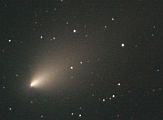
Fragment B
with spreading tail
8.5.06, (UTC 2:00 -
3:00)
Passage of fragment C
near M57

GIF, Movement
of the comet
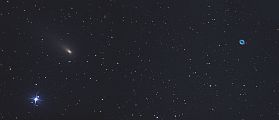 tb
tb
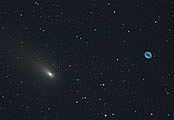 tb´
tb´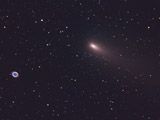 mr
mr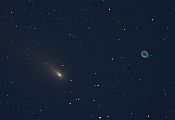 tb
tb
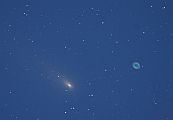 tb
tb
7.5.06, (UTC 1:00)
Nucleus outbrakes
against the tail direction. The fragment B luminance increased rapidly to
mag 4-5
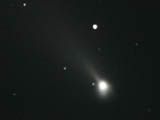 tb
tb
Newton 12,5", Dig. 3040mm x3, 40sec, 800 ASA,
25sec ASA 1600, Canon 20D
6.5.06, (UTC 2:00 -
3:00)
Nucleus splitting in
three parts of frg. B.
(Martin Rietze)
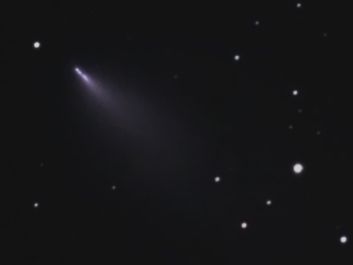

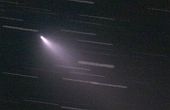 mr
mr
GIF, Movement
of the comet
5.5.06, (UTC 1.30 -
2:30)
Again a nucleus
splitting of fragment B !!
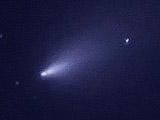
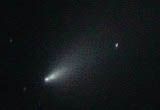
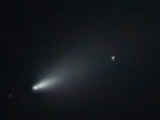
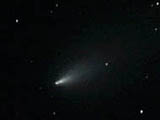 tb
tb
Newton 12,5", Dig. 3040mm x3
(Window left), 50sec, 800 ASA, Canon 20D
4.5.06, (UTC 1:00)
Fragment B is passing
the globular cluster M13
 tb
tb
Nikon Dig. 480 mm / 2.8
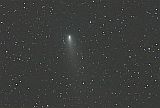 tb
tb
Fragment C. Nikon Dig. 480 mm /
2.8
 tb
tb
The two
fragments in the constellation Hercules.
Fragment B (left) is passing the globular cluster M13. This high
resolution batch is a composit with 20 pictures. (Nikon Dig. 480 mm / 2.8,
Exp. 50 sec). Image turned at 180°)
3.5.06, (UTC 0:00 - 1:00)
The splitting of fragment B
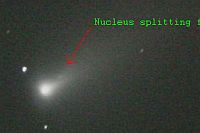
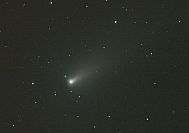 tb
tb
The splitting of fragment B, The
brightness has gone up from mag 8.0 to mag 4 , Newton 12,5", Dig. 3040mm
30.4.06
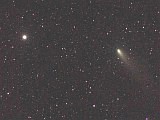
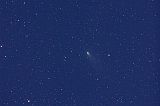 tb
tb
1) Fragment C,
mag 6,8 2) Fragment
B, Nikon 480mm / 2.8
25.4.06, 1:30 - 2:30 MESZ
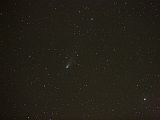 1
1
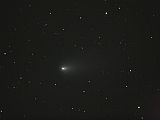 2 tb
2 tb
TB, 1) Nikon 480mm / 2.8
2) Newton 12,5" / 3040 mm digital, 90 sec , ASA 800, Canon 20D
*mag
= > light
magnitude:
Up to
mag +3-4 stars are visible nearby cities with
the naked eye, in very dark areas the seeing limit can reach up
to
mag +6-7.
The more higher numerical value is
given, the more weaker are the objects. E.g.
- 4,7 mag,
Venus glittering;
- 1,0
Sirius, brightest star;
+3,5
M31 Andromeda,
pale shiny oval)
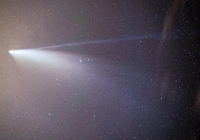








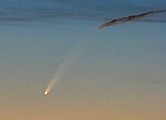

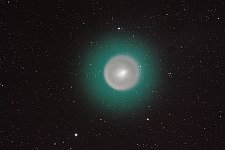
All comet observations
from 2001 up to now ..
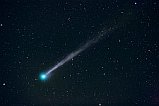

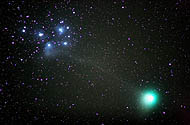
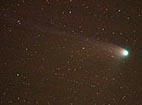








Links

Comet 73P/ Schwassmann-Wachmann 3
 astronomie.de
astronomie.de
After its discovery in 1930 by Arnold Schwassmann and Arno Wachmann at the observatory Hamburg/Bergedorf the comet is 76 years later expected to be mag 4,5 at best, and to be visible with naked eyes in the middle of may 2006. Its orbiting time around the sun takes 5, 4 years.
The brightest fragments C and B (there are more than 60 smaller parts) will pass the earth in a distance of 10 - 11 Mio. Km. The fainter part E will approach to the earth in a range of 7,6 Mio Km. This is only 20 times more than the average moon distance.
The recent observation shows that the fragment B is falling apart and is splitting continiously. Strong outbursts and alternating luminance could be observed from our telescopes in Fuerstenfeldbruck/Gilching. The fragment C is stabile increasing in its brightness and no splitting was discovered until now. Fragment C has now the brightness of apprx. 5, 5 mag. Fragment B is partly changing from 4,0 mag (8.5.06) to 6 mag.
In case of the near 'fly by', there is no danger for our planet but a meteor shower like in 1930 may appear again in May and June. But this time the earth will not pass through the dust trail in calculation. Nevertheless surprises are welcome! (12.5.06)


























